tow CHEVROLET CAMARO 1995 4.G User Guide
[x] Cancel search | Manufacturer: CHEVROLET, Model Year: 1995, Model line: CAMARO, Model: CHEVROLET CAMARO 1995 4.GPages: 388, PDF Size: 19.69 MB
Page 83 of 388

Downloaded from www.Manualslib.com manuals search engine Shifting Into PARK (P)
(Automatic Transmission Models only)
1. Hold the brake pedal down with your right foot and
set the parking brake.
2. Move the shift lever into PARK (P) position by
holding in the button on the lever, and push the lever
all the way toward the front
of your vehicle.
3. Move the ignition key to LOCK.
4. Remove the key and take it with you. If you can
walk away
from your vehicle with the ignition key in
your hand, your vehicle is in PARK (P).
2-31
Page 85 of 388
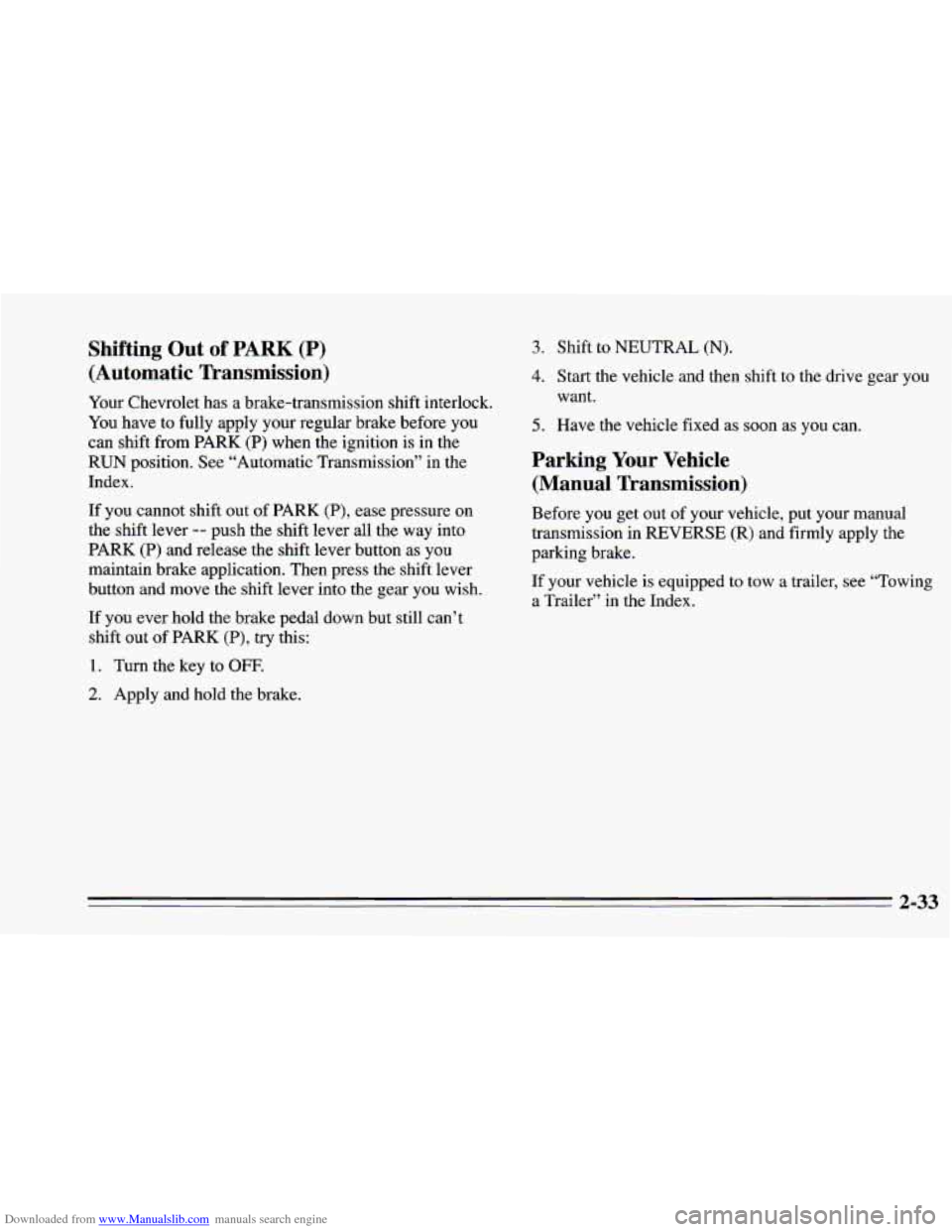
Downloaded from www.Manualslib.com manuals search engine Shifting Out of PARK (P)
(Automatic Transmission)
Your Chevrolet has a brake-transmission shift interlock.
You have to fully apply your regular brake before
you
can shift from PARK (P) when the ignition is in the
RUN position.
See “Automatic Transmission” in the
Index.
If you
canil6t shift out of PARK (P), ease pressure on
the shift lever
-- push the shift lever all the way into
PARK (P) and release the shift lever button as you
maintain brake application. Then press the shift lever
button and move the shift lever into the gear you wish.
If you ever hold the brake pedal down but still can’t
shift out of PARK
(P), try this:
1. Turn the key to OFF.
2. Apply and hold the brake.
3. Shift to NEUTRAL (N).
4. Start the vehicle and then shift to the drive gear YOU
want.
5. Have the vehicle fixed as soon as you can.
Parking Your Vehicle
(Manual Transmission)
Before you get out of your vehicle, put your manual
transmission in REVERSE (R) and firmly apply the
parking brake.
If your vehicle is equipped to tow a trailer, see “Towing
a Trailer” in the Index.
2-33
Page 87 of 388
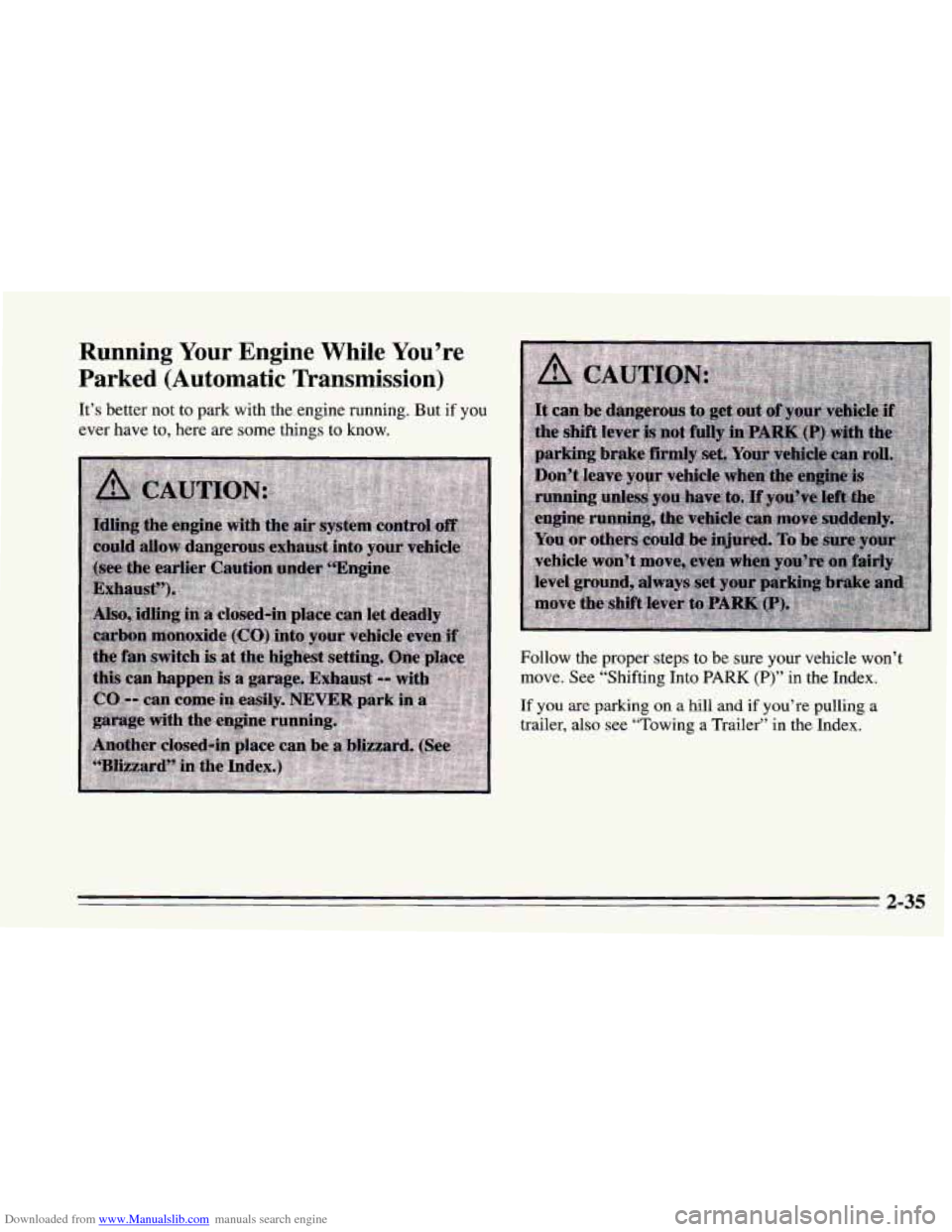
Downloaded from www.Manualslib.com manuals search engine Running Your Engine While You’re
Parked (Automatic Transmission)
It’s better not to park with the engine running. But if you
ever have to, here are
some things to know.
Follow the proper steps to be sure your vehicle won’t
move, See “Shifting Into PARK (P)” in the Index.
If
you are parking on a hill and if you’re pulling a
trailer,
also see “Towing a Trailer” in the Index.
2-35
Page 91 of 388
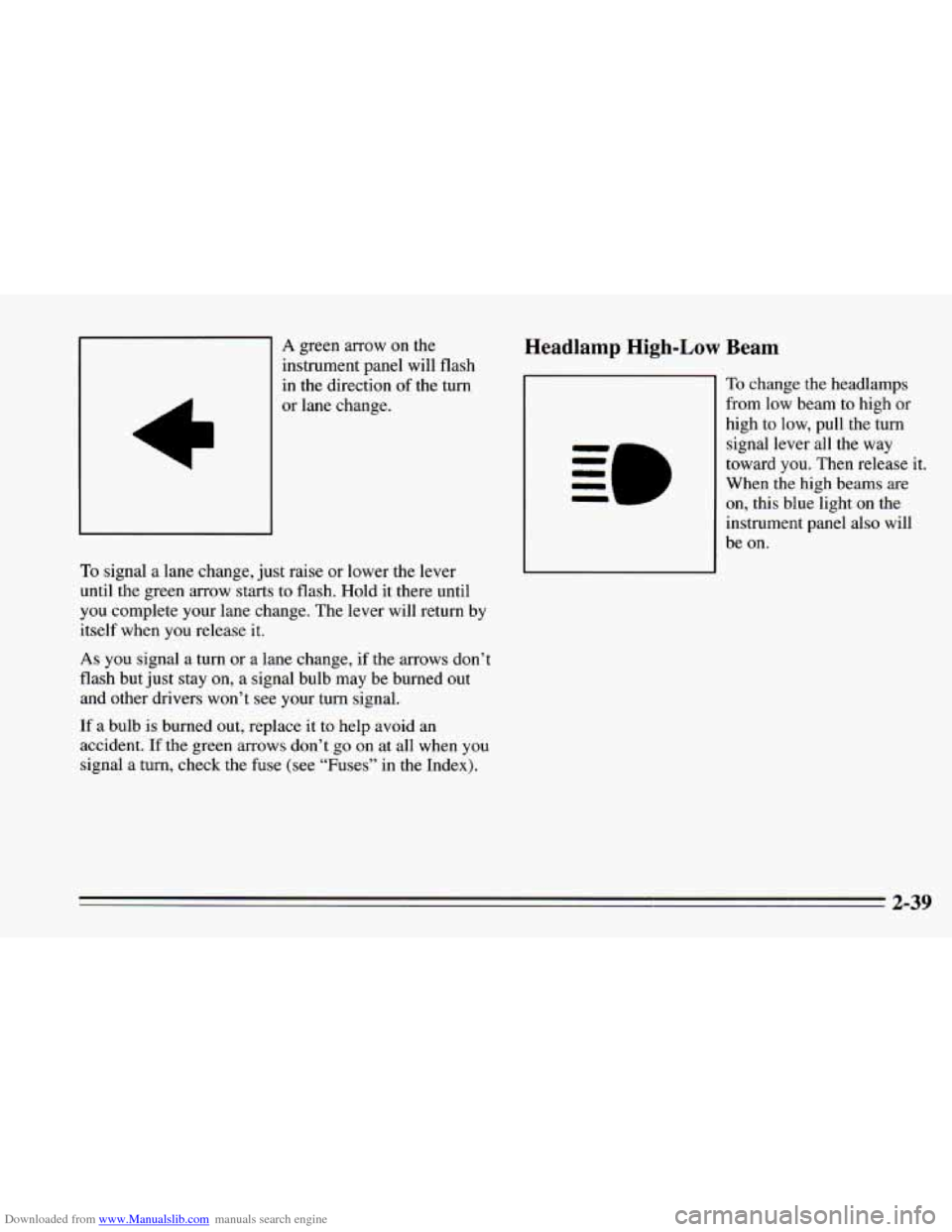
Downloaded from www.Manualslib.com manuals search engine A green arrow on the
instrument panel will flash
in the direction of the turn
or lane change.
To signal a lane change, just raise or lower the lever
until the green arrow starts to flash. Hold it there until
you complete your lane change. The lever will return by
itself when you release it.
As you signal a turn or a lane change, if the arrows don’t
flash but just stay
on, a signal bulb may be burned out
and other drivers won’t see your turn signal.
If a bulb is burned out, replace it to help avoid an
accident.
If the green arrows don’t go on at all when you
signal a turn, check the fuse (see “Fuses” in the Index).
Headlamp High-Low Beam
To change the headlamps
from low beam to high or
high to low, pull the turn
signal lever all the way
toward
you. Then release it.
When the high beams are
on, this blue light on the
instrument panel also will
be
on.
2-39
Page 105 of 388
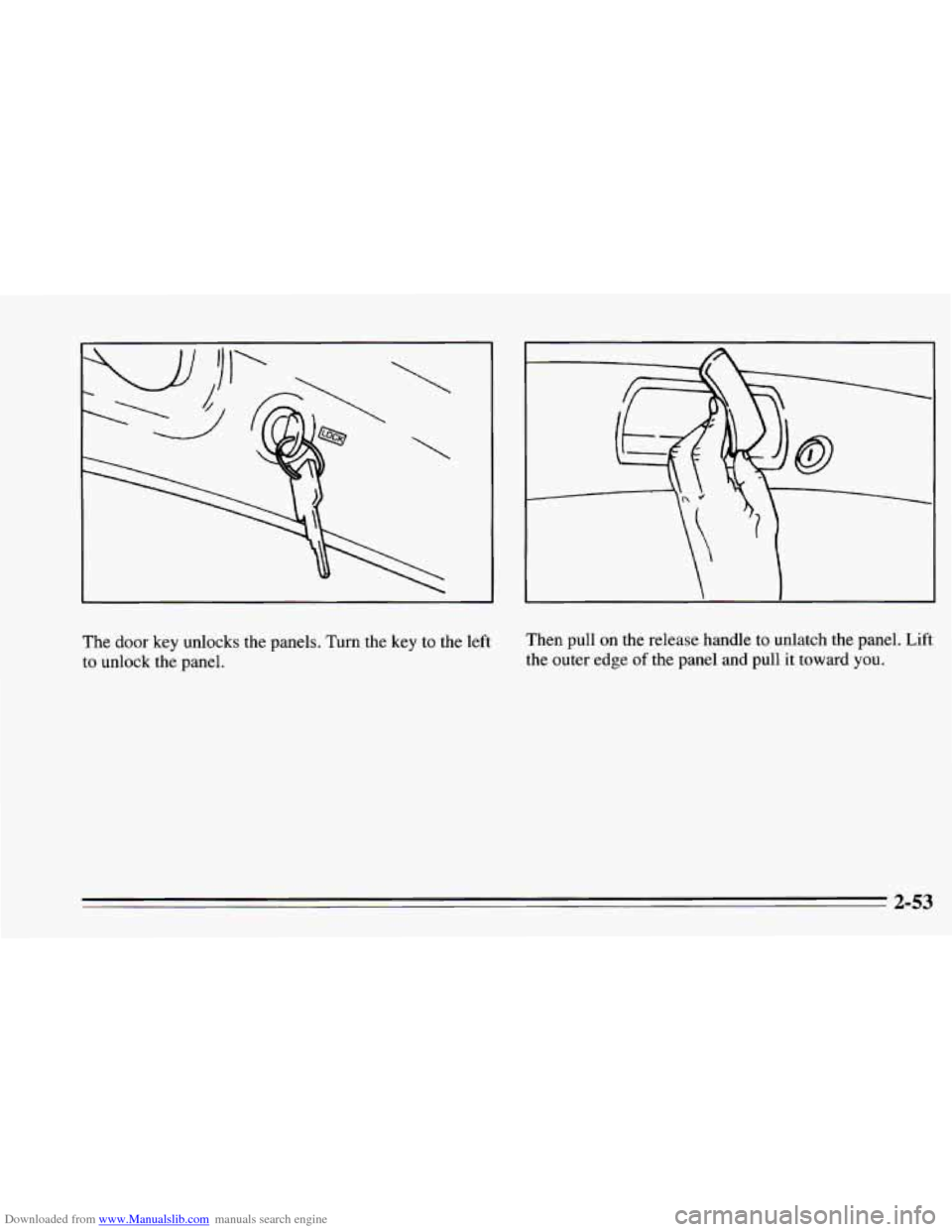
Downloaded from www.Manualslib.com manuals search engine
The door key unlocks the panels. Turn the key to the left Then
pull on the release handle to unlatch the panel. Lift
to unlock the panel. the
outer edge
of the panel and pull it towad you.
2-53
Page 112 of 388
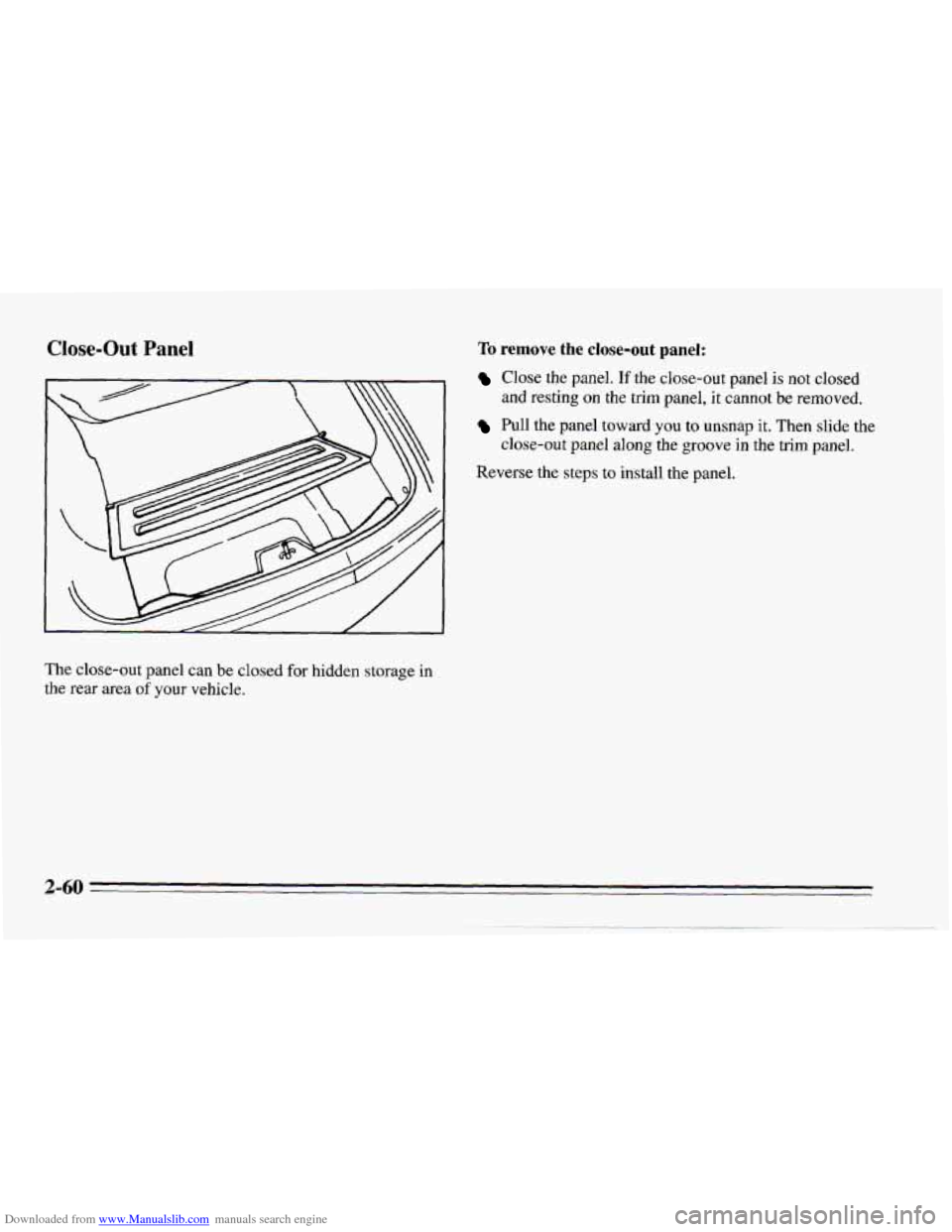
Downloaded from www.Manualslib.com manuals search engine Close-Out Pane1
The close-out panel can be closed for hidden storage in
the rear area of your vehicle.
To remove the close-out panel:
Close the panel. If the close-out panel is not closed
and resting on the trim panel, it cannot be removed.
Pull the panel toward you to unsnap it. Then slide the
close-out panel along the groove
in the trim panel.
Reverse the steps to install
the panel.
2-60
Page 121 of 388

Downloaded from www.Manualslib.com manuals search engine Air Bag Readiness Light
There is an air bag readiness light on the instrument
panel, which shows
AIR BAG.
AIR BAG
The system checks the air
bag’s electrical system for
malfunctions. The light
tells you if there is an
electrical problem.
The system check includes the air bag sensors and
modules, the wiring and the diagnostic module. For
more information on the
air bag system, see “Air Bag”
in the Index.
You will see this light flash for a few seconds when you
turn your ignition to
RUN or START. Then the light
should go out. This means the system is ready.
If the
air bag readiness light doesn’t come on when you
start your vehicle, or stays on, or comes on when you
are driving, your air bag system may not work properly.
Have your vehicle serviced right away.
Brake System Warning Light
Your Chevrolet’s hydraulic
brake system is divided into
two parts. If one part isn’t
working, the other part
can
still work and stop you. For
good braking, though, you
need both parts working
well.
If the warning light comes on, there could be a brake
problem. Have your brake system inspected right away.
This light should come on briefly as you start the
vehicle.
If it doesn’t come on then, have it fixed so it
will be ready
to warn you if there’s a problem.
If the light comes on while you are driving, pull
off the
road and stop carefully. You may notice that the pedal is
harder to push. Or, the pedal may go closer to the floor.
It may take longer to stop. If the light
is still on, or if the
anti-lock brake system warning light is flashing, have
the vehicle towed for service. (See “Anti-Lock Brake
System Warning Light” and “Towing Your
Car” in the
Index.)
2-69
Page 122 of 388
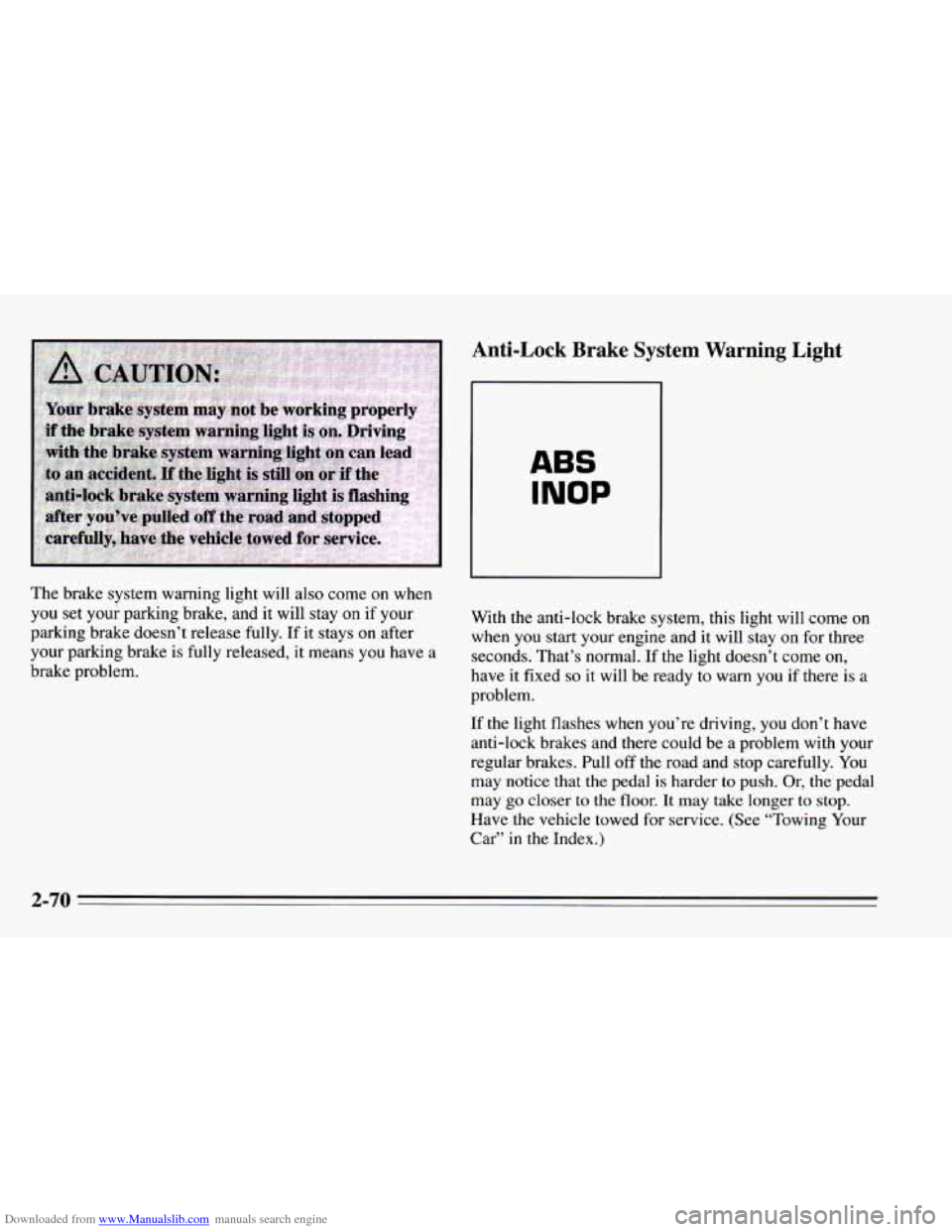
Downloaded from www.Manualslib.com manuals search engine The brake system warning light will also come on when
you set your parking brake, and it will stay
on if your
parking brake doesn’t release fully. If it stays
on after
your parking brake is fully released, it means you have a
brake problem.
Anti-Lock Brake System Warning Light
INOP
With the anti-lock brake system, this light will come on
when
you start your engine and it will stay on for three
seconds. That’s normal. If the light doesn’t come
on,
have it fixed so it will be ready to warn you if there is a
problem.
If the light flashes
when you’re driving, you don’t have
anti-lock brakes and there could be a problem with your
regular brakes. Pull off the road and stop carefully. You
may notice that the pedal is harder to push. Or, the pedal
may go closer
to the floor. It may take longer to stop.
Have
the vehicle towed for service. (See “Towing Your
Car” in the Index.)
2-70
Page 140 of 388
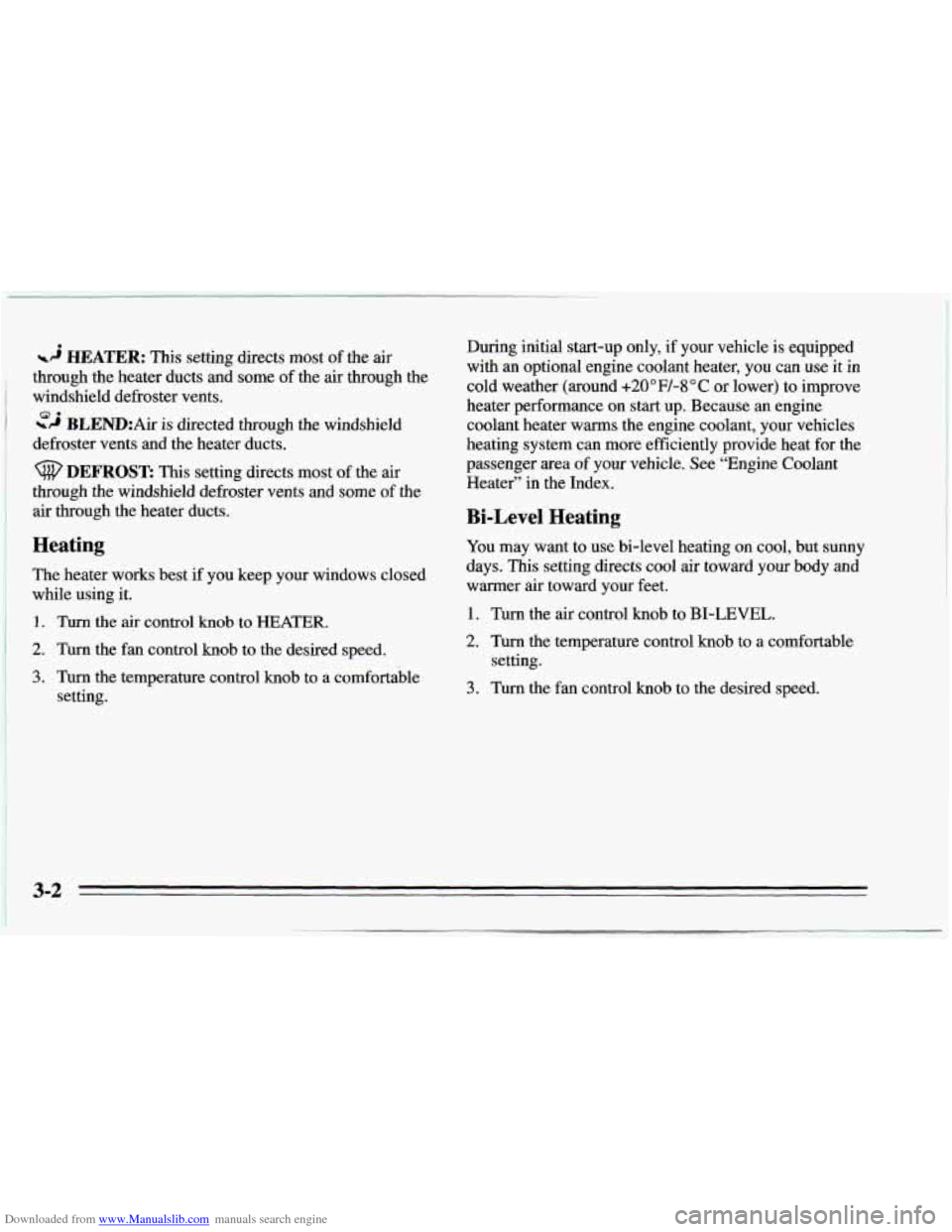
Downloaded from www.Manualslib.com manuals search engine -3 HEATER: This setting directs most of the air
through the heater ducts and some of
the air through the
windshield defroster vents.
zi BLEND:Air is directed through the windshield I I defroster vents and the heater ducts.
I DEFROST: This setting directs most of the air
j through the windshield defroster vents and some of the
air through the heater ducts.
I Heating
I The heater works best if you keep your windows closed
while using it.
, 1. Turn the air control knob to HEATER.
2. Turn the fan control knob to the desired speed.
~ 3. Turn the temperature control knob to a comfortable
setting. During
initial start-up only, if your vehicle
is equipped
with an optional engine coolant heater,
you can use it in
cold weather (around
+20°F/-8”C or lower) to improve
heater performance
on start up. Because an engine
coolant heater warms the engine coolant, your vehicles
heating system can more efficiently provide heat for the
passenger area of your vehicle. See “Engine Coolant
Heater” in the Index.
Bi-Level Heating
You may want to use bi-level heating on cool, but sunny
days. This setting directs cool air toward your body and
warmer air toward your feet.
1. Turn the air control knob to BI-LEVEL.
2. Turn the temperature control knob to a comfortable
3. Turn the fan control knob to the desired speed.
setting.
3-2
Page 187 of 388
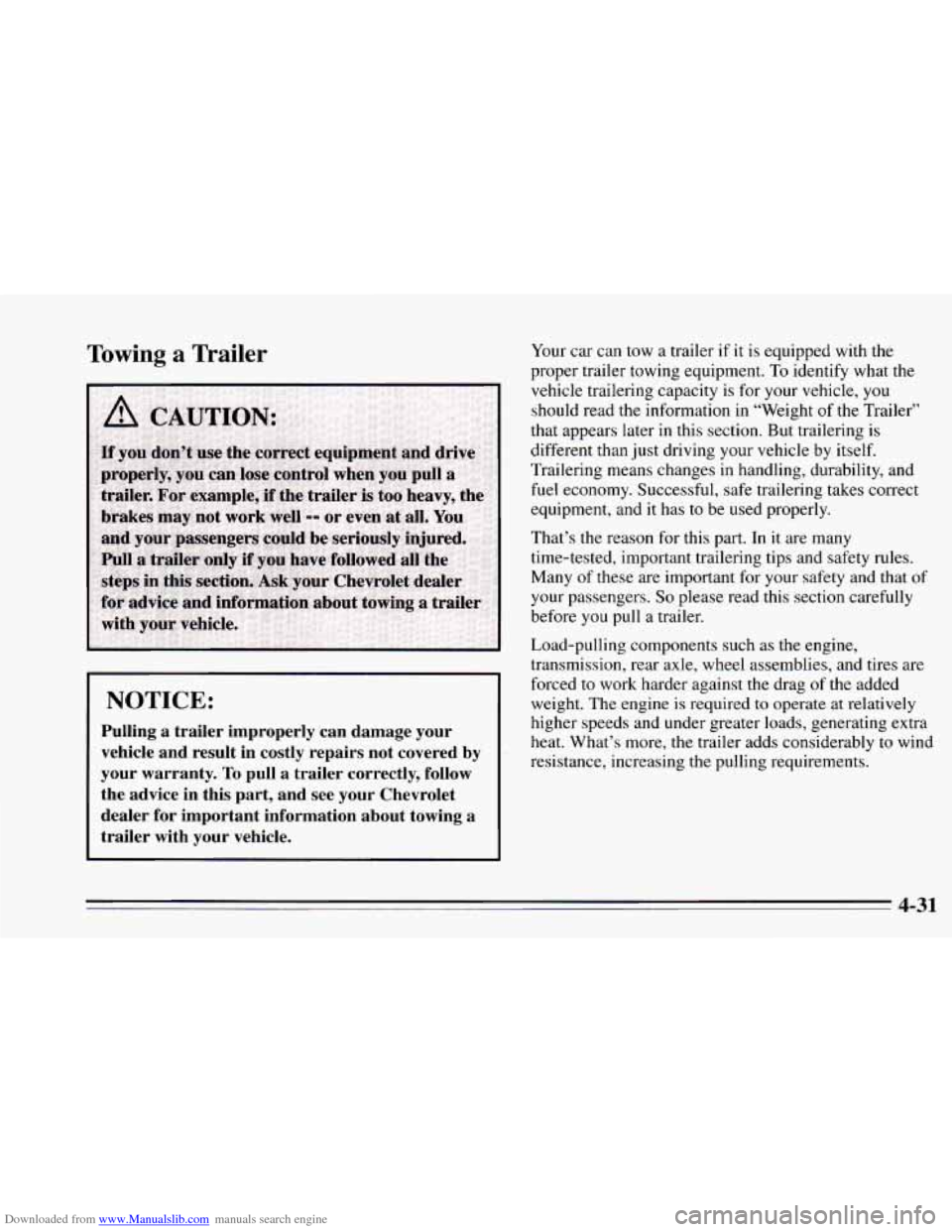
Downloaded from www.Manualslib.com manuals search engine Towing a Trailer
NOTICE:
Pulling a trailer improperly can damage your
vehicle and result in costly repairs not covered
by
your warranty. To pull a trailer correctly, follow
the advice in this part, and see your Chevrolet
dealer for important information about towing a
trailer with your vehicle.
Your car can tow a trailer if it is equipped with the
proper trailer towing equipment. To identify what the
vehicle trailering capacity is for your vehicle,
you
should read the information in “Weight of the Trailer”
that appears later
in this section. But trailering is
different than just driving your vehicle by itself.
Trailering means changes in handling, durability, and
fuel economy. Successful, safe trailering takes correct
equipment, and
it has to be used properly.
That’s the reason for this part. In
it are many
time-tested, important trailering tips and safety rules.
Many of these are important for your safety and that
of
your passengers. So please read this section carefully
before you pull a trailer.
Load-pulling components such as the engine,
transmission, rear axle, wheel assemblies, and tires are
forced to work harder against the drag
of the added
weight. The engine
is required to operate at relatively
higher speeds and under greater loads, generating extra
heat. What’s more, the trailer adds considerably
to wind
resistance, increasing the pulling requirements.
4-31